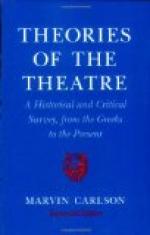Only to a slightly less extent is the dramatist at the mercy of his stage-director. Mrs. Rida Johnson Young’s silly play called Brown of Harvard was made worth seeing by the genius of Mr. Henry Miller as a producer. By sheer visual imagination in the setting and the handling of the stage, especially in the first act and the last, Mr. Miller contrived to endow the author’s shallow fabric with the semblance of reality. On the other hand, Mr. Richard Walton Tully’s play, The Rose of the Rancho, was spoiled by the cleverest stage-director of our day. Mr. Tully must, originally, have had a story in his mind; but what that story was could not be guessed from witnessing the play. It was utterly buried under an atmosphere of at least thirty pounds to the square inch, which Mr. Belasco chose to impose upon it. With the stage-director standing thus, for benefit or hindrance, between the author and the audience, how is the public to appreciate what the dramatist himself has, or has not, done?
An occasion is remembered in theatric circles when, at the tensest moment in the first-night presentation of a play, the leading actress, entering down a stairway, tripped and fell sprawling. Thus a moment which the dramatist intended to be hushed and breathless with suspense was made overwhelmingly ridiculous. A cat once caused the failure of a play by appearing unexpectedly upon the stage during the most important scene and walking foolishly about. A dramatist who has spent many months devising a melodrama which is dependent for its effect at certain moments on the way in which the stage is lighted may have his play sent suddenly to failure at any of those moments if the stage-electrician turns the lights incongruously high or low. These instances are merely trivial, but they serve to emphasise the point that so much stands between the dramatist and the audience that it is sometimes difficult even for a careful critic to appreciate exactly what the dramatist intended.
And the general public, at least in present-day America, never makes the effort to distinguish the intention of the dramatist from the interpretation it receives from the actors and (to a less extent) the stage-director. The people who support the theatre see and estimate the work of the interpretative artists only; they do not see in itself and estimate for its own sake the work of the creative artist whose imaginings are being represented well or badly. The public in America goes to see actors; it seldom goes to see a play. If the average theatre-goer has liked a leading actor in one piece, he will go to see that actor in the next piece in which he is advertised to appear. But very, very rarely will he go to see a new play by a certain author merely because he has liked the last play by the same author. Indeed, the chances are that he will not even know that the two plays have been written by the same dramatist. Bronson Howard once told me that he was very sure




